

Paolo Vietti-Violi (June 20, 1882, Grandson, Switzerland - December 25, 1965, Vogogna, Italy) was an Italian architect. His work was part of the architecture event in the art competition at the 1928 Summer Olympics. [1]


Paolo Vietti-Violi (June 20, 1882, Grandson, Switzerland - December 25, 1965, Vogogna, Italy) was an Italian architect. His work was part of the architecture event in the art competition at the 1928 Summer Olympics. [1]

Born in the French-speaking Switzerland from Italian parents who resided there for business, he studied in Geneva and Paris (at the Ecole des Beaux-Arts) from which he graduated in 1907.
He moved to Milan where in 1914 he re-graduated at the Royal Polytechnic in order to practice his profession in Italy. [2] He then began a career as a designer in the field of sports facilities such as racetracks, stadiums and their complementary structures. His design universe, however, was very large and varied, as evidenced by the different architectural aspects, which are identifiable in the rationalism of the time, still soaked from the original neo-classical French style.
He worked not only in Italy but also in several countries of the Central Europe; he also realized several projects in Turkey, [3] then in India, East Africa and South America (including a Jockey Club in Argentina).
His skills gained him the respect of kings, rulers and aristocrats. In 1907 he married Maria Biraghi Lossetti, an aristocratic heiress of the Lords of Vogogna Biraghi Lossetti, who bore him the following year his son Emanuele, who became an architect and his collaborator in Milan. He was an artillery officer in Genoa during the First World War and in 1944 he became the Mayor of Vogogna during the partisan Republic of Ossola.
Vietti-Violi died in Vogogna at 83 on the Christmas Day of 1965. He was still working on the racecourse Parilly of Lyon and at the new church of Villadossola assisted by his assistant at the time, the architect Vladimiro Francioli.
Paolo Vietti-Violi's sketches can be found in the collection of Milan Jovanović Stojimirović who bequeathed his vast collection of paintings, etchings and artifacts to the Art Department of the Museum in Smederevo. [4]
An important contribution of Vietti Violi at national and international level was in sport. Vietti-Violi observed in Casabella , the international monthly dedicated to architecture: "... the rebirth of sport and, above all, the spirit of sport in Italy, as directed and organized by the fascist regime, initiated directly on an impressive renovation of sports works". His designs for sports facilities have emphasized the importance of planning the overall context: public transport and access road links, parking and stadium turnstiles. He has designed and supervised works for the construction of more than 33 racecourses, stadiums and sports facilities in Italy and abroad. Among the national ones:
Later designs include the Lido racecourse in Venice, Italy, with canter and trot facilities, stables for 260 horses.
In 1913 he went to Argentina, where he was invited to design the new headquarters of the Association Jockey Club of Buenos Aires.
Subsequently he went to Bombay in India, invited by the Western India Turf Club for the selection of designers for the construction of two racecourses in Bombay and Poona.
From 1930 to 1932 he became technical advisor of the Monza racetrack.
In 1932, with the young Hungarian Andreas Benko who collaborated in his studio, he created in Selvino (Bergamo) the Sciesopoli di Selvino, a mountain colony for children commissioned by fascism and named after Antonio Sciesa, hero of the Risorgimento, inaugurated on 11 June 1933. The large colony consists of a complex of avant-garde buildings, completed in a very short time. The colony was equipped with dormitories, refectories, a heated swimming pool, cinema, infirmary, a large park of 17,000 square meters and courtyards for assemblies. Among the numerous financiers of the work who offered a total of 2,580,000 lire, as evidenced by the marble plaque in the entrance hall, there was the Duce Benito Mussolini, who donated 5,000 lire for its construction.
In 1937 in Yugoslavia, he was contacted for the project of the hippodrome of Zemun in Belgrade in Yugoslavia and sports facilities in Sarajevo.
In 1937 in Poland, he was contacted for the Warsaw hippodrome project by the local Jockey Club.
In 1939 in Ethiopia, at the invitation of Equine Breeds Encouragement Society (S.I.R.E.), and request of the Vice King of Ethiopia, the Duke of Aosta, for the complete sports facilities in Addis Ababa.
In 1948 in Bulgaria, he was interviewed by the Bulgarian Government for the project of complete sports facilities in Sofia.
In 1950 in Venezuela, he was invited by the government to study a drainage project for horse racing tracks. Carries out projects for complete sports facilities and the executive project for the racecourse of Valencia, Venezuela.
Subsequently he carried out the project of the San Martino Stadium in Genoa.
The architect Vietti Violi has designed numerous indoor swimming pools during the years of his activity in Italy:
covered swimming pool for the complex of sports facilities of l'Aquila in Abruzzo;
indoor swimming pool for the "Casa del Balilla" complex and related sports facilities Colonia Alpina di Sciesopoli in Selvino in province of Bergamo;
covered swimming pool for the "Casa del Balilla" complex and related sports facilities in Saronno, in Lombardy;
The architect created the Palazzetto dello Sport at the Milan Fair, with the cycle path, which opened in April 1923 and the sports facilities of San Martino d'Albaro, L'Aquila, Merano, Saronno and Milano Marittima (Canella Giuntini, 2009)
In 1936, Vietti Violi's project was inaugurated in Ankara for the expansion to 60,000 seated spectators of the stadium 19 Mayıs Stadio ("May 19 Sports Stadium"), then the scene of many celebrations of national holidays. In a published description of the project, Vietti Violi mentions the militaristic connotations of sports activities in the 1930s: the stadium complex was "a grandiose and exceptional program which made it necessary to create a wide street for military parades" (Bozdoğan, 2001 ). Participates in the competition for the design of the Mustafa Kemal Atatürk mausoleum, in Anıtkabir (Christopher S. Wilson, 2009). Later in his career he designed BJK İnönü Stadium in Istanbul, Turkey, completed in 1954.
Vietti Violi participated in numerous design competitions for large civil works: hospitals (Pavia), factories, theaters (Genoa), basilicas (Syracuse), public structures including regional buildings.
He built important workers' villages in Villadossola for about 1000 workers and in Pieve Vergonte he designed the workers' village, offices, laboratories and factories of the local industrial complex.
He participated in numerous competitions:
The architect Vietti Violi created numerous projects for private villas:
He also carried out numerous projects for residential, hotel and office buildings:
Vietti Violi created projects for religious buildings:
He participated in numerous competitions of religious works:

Galeazzo Alessi was an Italian architect from Perugia, known throughout Europe for his distinctive style based on his enthusiasm for ancient architecture. He studied drawing for civil and military architecture under the direction of Giovanni Battista Caporali.

EUR is a residential and business district in Rome, Italy, part of the Municipio IX.

Giancarlo De Carlo was an Italian architect.
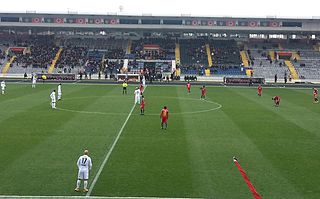
The Ankara 19 Mayıs Stadium was the main stadium of Ankara and was used by Gençlerbirliği and Ankaragücü as their home venue, until its closure in 2018. It was built in 1930 and is part of the 19 Mayıs Sports Complex, which is located in the Ulus district. The stadium had a capacity of 19,209 (all-seater). Ankaraspor also used the stadium until they moved to their new venue in the Yenikent district.

Giacomo della Porta (1532–1602) was an Italian architect and sculptor, who worked on many important buildings in Rome, including St. Peter's Basilica. He was born at Porlezza, Lombardy and died in Rome.
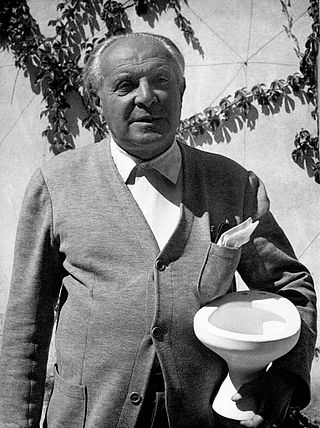
Giovanni "Gio" Ponti was an Italian architect, industrial designer, furniture designer, artist, teacher, writer and publisher.
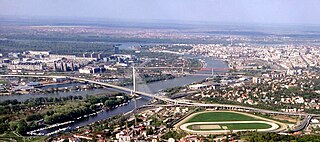
Careva Ćuprija is an urban neighborhood of Belgrade, the capital of Serbia. It is located in Belgrade's municipality of Čukarica.
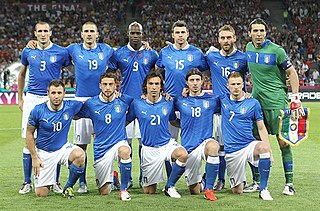
Sport in Italy has a long tradition. In several sports, both individual and team, Italy has good representation and many successes. The most popular sport in Italy is football. Italy's national football team is one of the world's most successful teams with four FIFA World Cup victories and two UEFA Euro victories. Italian clubs have won 48 major European trophies, making Italy the second most successful country in European football. Italy's top-flight club football league is named Serie A and is followed by millions of fans around the world.

Pieve Vergonte is a comune (municipality) in the Province of Verbano-Cusio-Ossola in the Piedmont region of Italy. It is about 20 kilometres (12 mi) northwest of Verbania and 110 kilometres (68 mi) northeast of Turin.

CityLife is a residential, commercial and business district situated a short distance from the old city centre of Milan, Italy; it has an area of 36.6 hectares. It is a redevelopment project on the former grounds of Fiera Milano after its relocation to the nearby town of Rho.

Capannelle Racecourse is a horse racing venue in Rome, Italy. The course was constructed in 1881, and it was rebuilt in 1926 to a design by Paolo Vietti-Violi.

Palazzo Mezzanotte, also known as Palazzo delle Borse is a 20th-century building of Milan, Italy, and the seat of the Italian stock exchange. It is located in Piazza Affari, the city square after which the Italian stock exchange itself is nicknamed. The name "Palazzo Mezzanotte" is a reference to Paolo Mezzanotte, the architect who designed the building.
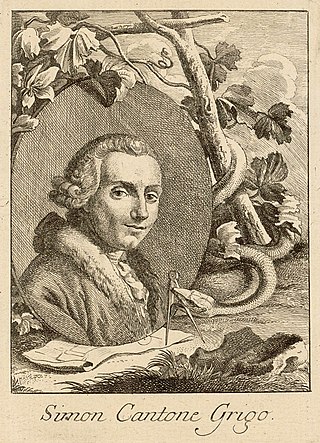
Simone Cantoni was a Swiss architect of the Neoclassical period, active mainly in Northern Italy.
Luigi Boffi was an Italian architect.

The Parco delle Cascine (Cascine Park) is a monumental and historical park in the city of Florence. The park covers an area of 160 hectares. It has the shape of a long and narrow stripe, on the north bank of the Arno river. It extends from the centre of Florence until the point where the Mugnone flows into the Arno.

Istanbul Lütfi Kırdar International Convention and Exhibition Center, often referred as Istanbul Lütfi Kırdar ICEC, shortly ICEC,, formerly Istanbul Sports and Exhibition Hall, is a multi-purpose convention complex located in Harbiye neighborhood of Şişli district in Istanbul, Turkey.

The Equestrian monument to Vittorio Emanuele II is an equestrian statue of the former King Vittorio Emanuele II, located in the Piazza Vittorio Veneto, a small green spot at the east end of the Parco delle Cascine, located along the Arno River, just west of central Florence, region of Tuscany, Italy.
Almaty hippodrome is a hippodrome opened in 1930 in Almaty, Kazakhstan. It is the oldest active sports facility for equestrian sport in the country.

The Hippodrome of San Siro is a horse racing venue in Milan, Italy, which takes its name from the neighborhood of the same name in which it is located.